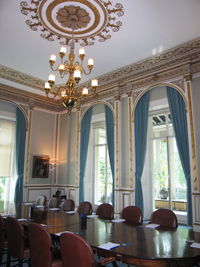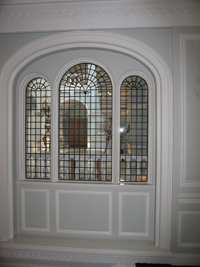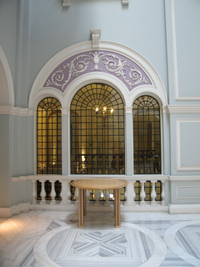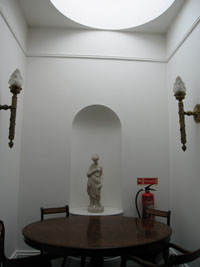Essay
David Walker. Dudley House, 100 Park Lane, London (2008).
Lewis Hammerson, founder-chairman of the Hammerson Group of property companies, first established a presence in Park Lane after the Second World War, when he commissioned Bernard Engle to restore a bow-fronted terrace house, no 129, as his headquarters. During the late 1960s the decision of Hammerson’s successor, Sydney Mason, to restore the bombed-out Dudley House as a new headquarters was a fine exercise in public relations at a time when the property industry had been brought into exceptional disrepute through the actions of speculators, and particularly, when concern over the reconstruction of towns and cities to the detriment of their historical character was becoming ever more widely and more deeply felt.
Dudley House, 100 Park Lane, was one of a handful of aristocratic mansions surviving in a thoroughfare which had itself been largely redeveloped for office and commercial use. It was named after the fourth Viscount Dudley and Ward, “the Lorenzo of the Black Country,” for whom it had been built in 1827-29 to designs by William Atkinson. Its external appearance was, appropriately, of simple Italianate character, and faced in stucco. It was three storeys high, its entrance elevation looking westwards to Hyde Park being symmetrical, nine windows broad and articulated in three divisions. The central one, with windows closely spaced, was slightly advanced, but chiefly distinguished by the porch which projected boldly across the basement area to the street. This had four columns in antis and was enclosed on its flanks by blind screen walls. The same Ionic order, in pairs, extended across the full breadth of the ground floor to support the open balcony of the piano nobile. During the Victorian period a conservatory with segment-headed windows was formed across this balcony, but otherwise the entrance elevation remained unaltered. Above the windows of the second floor, a plain frieze and simple cornice announced the balustrade concealing the low-pitched roof, and a central parapet with the Dudley coat-of-arms.
The conservatory may have been the work of Samuel Daukes, who in 1855 at the behest of the eleventh Lord Dudley engaged in the substantial enlargement of the house. Daukes was responsible for the 80 feet picture gallery built across the rear flank at first floor level, and for the ballroom into which it opened on the northern side. In contrast to the earlier Atkinson interiors, which were in Graeco-Roman style, both of these apartments were French in character. The top-lit picture gallery – in green and gold, to set off a collection of Flemish and Italian paintings – had parquet flooring, scagliola columns and crystal gasoliers, while the ballroom was a reminiscence of Versailles, its walls lined with mirrors and tapestries. It is thought that some of Atkinson’s interiors, notably the entrance hall and principal stair, may have been redecorated in French styles to match.[1]
The appearance of the house began to deteriorate in 1930 when the stucco was removed from the elevations. It suffered severe damage during the blitz, the picture gallery and ballroom being the worst casualties. Thereafter it reverted from the Lords Dudley into the possession of the Grosvenor Estate as ground landlord, and was leased as offices for the first time. In the conversion process additional floors were inserted into the Daukes apartments, and what remained of their interiors was stripped out. Partitions were put up in the other rooms, cutting across existing decorative features. By the late 1960s, when Hammerson’s first took an interest, the building was in a dire state of repair. Hammerson’s had retained Sir Basil Spence as their architectural adviser for all new developments, but in England at least, the reconstruction of 100 Park Lane would be his largest commission.
The clients determined that the Reception, Secretariat, Offices and Overseas Departments and the Model Room should be on ground floor; that the Directors should occupy the first floor piano nobile; and that the Provincial and Joint Development Departments should be on second floor. The attics would be given over to lawyers and accountants, and the basement to the Filing Department, strong room, workshop, chauffeurs’ room and women’s rest-room. A link was to be formed from the first floor to the stables behind Dudley House which would be converted into company flats and an entertainment suite.[2]
Between 1969 and 1970 Dudley House was substantially rehabilitated, Basil Spence and Anthony Blee undertaking the work with Robert Clements and Francis Widdowson as assistants.[3] The elevations were faced with stucco to recover their earlier appearance, and the railings which had been removed during the war were reinstated. Internally, the decorative features of many of the rooms were restored. The ground floor dining room towards the rear of the house with its gilded ceiling became the Model Room. At first floor, the blue drawing room in the centre of the Park Lane elevation and the yellow drawing room adjoining it to the south, again with good ceilings, became respectively Sydney Mason’s Room and the Board Room. Both received new fireplaces. The Chairman’s fireplace was a mid-Victorian example, complete with over-mantel mirror, which was transferred with a dado from the red drawing room as that remained divided; the Board Room’s fireplace was of later eighteenth century date in the Adam style, and came from Gloucester House. Like several others it was chosen by the architects, who also selected antique and contemporary furnishings, and gave advice on the purchase of paintings.[4] The clients’ desire to maximise their office space resulted in the Daukes gallery and ballroom remaining divided both horizontally and vertically, but something of those apartments found its way into a classical stair-hall which was formed in a light-well to improve office circulation, since moulds for its coved ceiling were taken from the ballroom’s to ensure authenticity of detail. As the window lighting the main stair had thus been made redundant, it was transferred to the larger of the two ground floor conference rooms as a decorative feature. The main house was connected to the stables at first floor by a cast-iron bridge. The gardens were planted by John St Bodfan Gruffydd, who at the time was President of the Institute of Landscape Architects.
In general, the materials were of the finest, but a sudden jump in estimates during the reconstruction work – primarily attributed to services – which took the total cost above what the clients were willing to pay, led to certain economies and a difficult relationship between the architects, the contractor, Sir Robert McAlpine, and Arthur Kelting who had been overseeing progress for Hammerson’s and had believed that the budgets were well under control.[5] As the works were nearing completion, on 16 March 1970 Spence wrote to Sydney Mason who was then in Australia, asking him to visit the new headquarters on his return and to tell him what he thought.[6] Mason was delighted: “I quite agree with you that the overall effect is magnificent and that you and Anthony have carried out a wonderful job,” he wrote back ten days later. “When we have finally settled in I feel sure that we will have the most splendid office accommodation in London – probably too good! We should sell the property to an Embassy,” he concluded brightly.[7] His commitment, and that of his architects, gained public recognition later that year when 100 Park Lane won a Civic Trust Award.[8]
100 Park Lane was sold by Hammerson’s in 2006 and converted back into a private residence.
[1] The details of this description owe particularly to the excellent summary, plan and photographs published in The Survey of London, Vols XXXIX and XL, The Grosvenor Estate in Mayfair (1977-80). The present author has also had recourse to Christopher Simon Sykes’ Private Palaces: Life in the Great London Houses (1985) and to David Pearce’s London Mansions: the Palatial Houses of the Nobility (1986).
[2] “Functional notes on 100 Park Lane for Sir Basil Spence” drafted by Arthur Kelting and dated 14 August 1968. R.C.A.H.M.S. SBS MS 2329/ENG/86/2/32-33.
[4] Letter from Basil Spence to Sydney Mason, 8 September 1969. R.C.A.H.M.S. SBS MS 2329/ENG/86/2/21-22.
[5] Letter from Arthur Kelting to Spence, 31 October 1969; letters from Spence to Kelting, 5 November 1969 and 6 January 1970. R.C.A.H.M.S. SBS MS 2329/ENG/86/2/13-16; 10-11; 7.
[8] For details, see booklet, Civic Trust Award 1970: copy with R.C.A.H.M.S., MS 2329/ENG/86/1/4. The assessor was Frederick MacManus.




